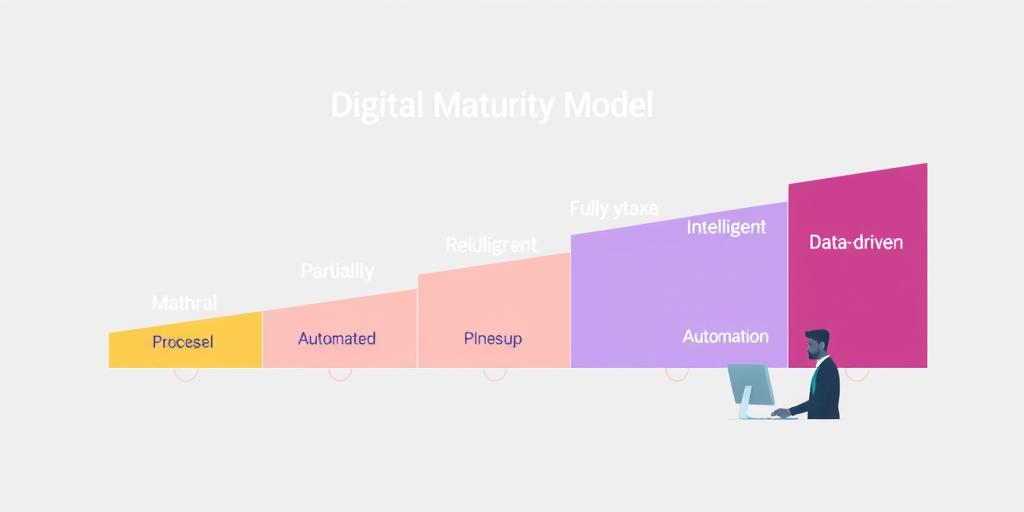In today’s rapidly evolving business landscape, understanding your organization’s digital maturity is crucial for achieving sustainable success. Digital maturity refers to an organization’s ability to leverage technology effectively to achieve its strategic goals. It’s not just about adopting the latest tools but about integrating them seamlessly into your business processes, culture, and mindset. By evaluating your digital maturity, you gain valuable insights into your strengths, weaknesses, and areas for improvement.
The Digital Maturity Model: A Framework for Success
What is Digital Maturity?
Digital maturity is the extent to which an organization has embraced digital technologies and processes to improve its operations, customer experiences, and overall performance. It’s a measure of how well your organization is equipped to adapt to the ever-changing digital landscape.
Why is Digital Maturity Important?
In a world dominated by technology, digital maturity is no longer a competitive advantage but a necessity. It allows businesses to:
- Stay relevant: Respond quickly to market changes and customer demands.
- Improve efficiency: Automate tasks, streamline workflows, and reduce costs.
- Enhance customer experience: Deliver personalized and seamless interactions.
- Gain a competitive edge: Differentiate your business and outperform competitors.
The Stages of Digital Maturity
The digital maturity model outlines different stages of development, each with its unique characteristics:
Stage 1: Reactive
Organizations in this stage are often characterized by a lack of digital strategy and rely heavily on manual processes. They react to technological advancements rather than proactively shaping their digital future.
Stage 2: Proactive
At this stage, organizations begin to embrace digital tools and processes. They implement basic technologies and explore opportunities to improve efficiency. However, they may still struggle to leverage data effectively and lack a comprehensive digital strategy.
Stage 3: Strategic
Organizations in this stage have developed a clear digital strategy aligned with their business goals. They utilize data analytics to drive decision-making and focus on customer-centric digital experiences.
Stage 4: Transformative
Organizations at the transformative stage are highly agile and data-driven. They leverage advanced technologies like AI and cloud computing to create innovative solutions and drive continuous improvement. They are constantly adapting and evolving to stay ahead of the curve.
Assessing Your Digital Maturity
Understanding your current digital maturity is the first step towards improvement. You can assess your organization’s digital maturity through various methods:
Key Performance Indicators (KPIs)
Identify relevant KPIs that measure your organization’s digital performance, such as website traffic, customer engagement, and conversion rates. Track these metrics over time to identify trends and areas for improvement.
Self-Assessment Tools
Numerous online tools and questionnaires are available to help you conduct a self-assessment. These tools often provide a comprehensive overview of your digital maturity across various aspects of your business.
External Audits
Engage with external consultants or industry experts to conduct a thorough assessment of your digital maturity. They can provide unbiased insights and recommendations based on their experience and industry knowledge.
Strategies for Improving Digital Maturity
Once you understand your current digital maturity, you can begin implementing strategies for improvement:
Invest in Technology and Infrastructure
Upgrade your technology infrastructure and invest in tools that support your digital transformation journey. This includes cloud computing, data analytics platforms, and cybersecurity solutions.
Develop a Digital Strategy
Create a clear and actionable digital strategy that aligns with your business goals. Define your target audience, identify key digital channels, and outline your approach to digital marketing, customer service, and innovation.
Foster a Culture of Innovation
Encourage experimentation, embrace new ideas, and foster a culture that embraces digital transformation. Create opportunities for employees to learn new skills and explore emerging technologies.
Empower Employees
Provide employees with the necessary training and resources to effectively utilize digital tools and technologies. Equip them with the skills and knowledge to navigate the evolving digital landscape.
Benefits of High Digital Maturity
Investing in digital maturity brings numerous benefits to your organization:
Increased Efficiency and Productivity
Automating tasks, streamlining workflows, and leveraging data analytics can significantly increase efficiency and productivity across your organization.
Enhanced Customer Experience
By leveraging digital technologies, you can deliver personalized and seamless customer experiences, leading to increased customer satisfaction and loyalty.
Improved Decision-Making
Access to real-time data and analytics allows you to make informed decisions based on insights rather than guesswork.
Competitive Advantage
Organizations with high digital maturity are better equipped to adapt to changing market conditions and gain a competitive advantage by embracing innovation and delivering exceptional customer experiences.
Embracing Digital Transformation
The future of business is digital. Organizations that embrace digital transformation and strive for continuous improvement will thrive in the years to come. By understanding and proactively managing your digital maturity, you can position your business for success in the ever-evolving digital world.
Investing in your digital maturity is not just about keeping up with the latest trends; it’s about strategically leveraging technology to achieve your business goals and create a sustainable future for your organization. Remember that digital maturity is a journey, not a destination. By embracing a mindset of continuous learning and improvement, you can navigate the digital landscape with confidence and success.




